GIGABYTE GB-BXi7H-5500 Broadwell BRIX Review
by Ganesh T S on January 29, 2015 7:00 AM ESTPerformance Metrics - I
The GIGABYTE GB-BXi7H-5500 was evaluated using our standard test suite for low power desktops / industrial PCs. We revamped our benchmark suite early last year after the publication of the Intel D54250WYK NUC review. We reran some of the new benchmarks on the older PCs also, but some of them couldn't be run on loaner samples. Therefore, the list of PCs in each graph might not be the same.
Futuremark PCMark 8
PCMark 8 provides various usage scenarios (home, creative and work) and offers ways to benchmark both baseline (CPU-only) as well as OpenCL accelerated (CPU + GPU) performance. We benchmarked select PCs for the OpenCL accelerated performance in all three usage scenarios. These scores are heavily influenced by the CPU in the system. The i7-5500U is obviously not as powerful as the i7-4770R in the BRIX Pro. As mentioned before, the main tussle is between the BXi7-4500 and BXi7H-5500, and here, the Broadwell-based unit takes a handy lead in all the Futuremark benchmarks. Note that both units were benchmarked with 16 GB of DDR3L memory running at 1866 MHz. This makes it more of a comparison of the CPUs themselves, rather than the rest of the system components.
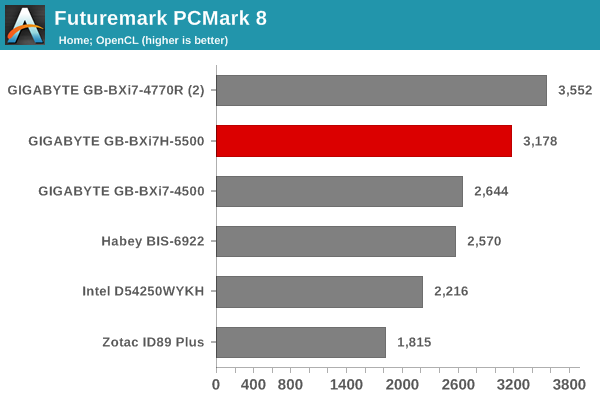
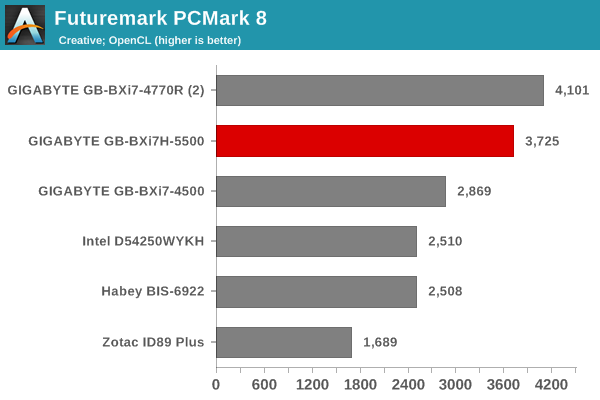
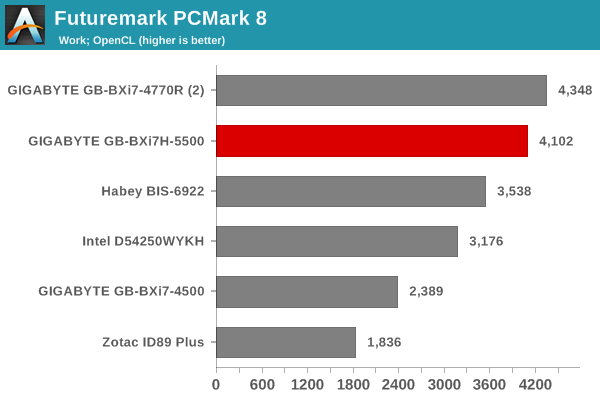
Miscellaneous Futuremark Benchmarks
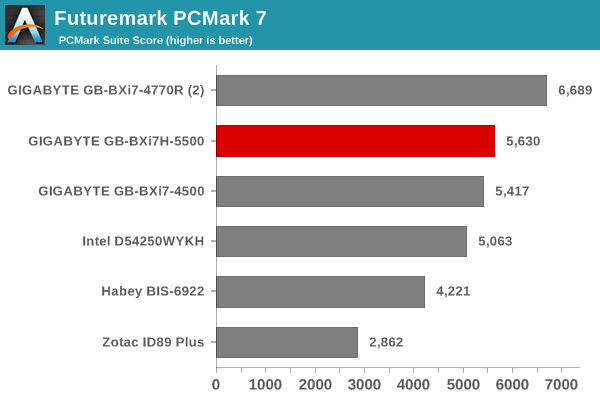
In the graphics department, we again see the i7-5500U perform better than the i7-4500U. The difference is very marked in the low end and mainstream tests, while the extreme high quality benchmarks still don't seem to be the Intel IGPs' cup of tea.
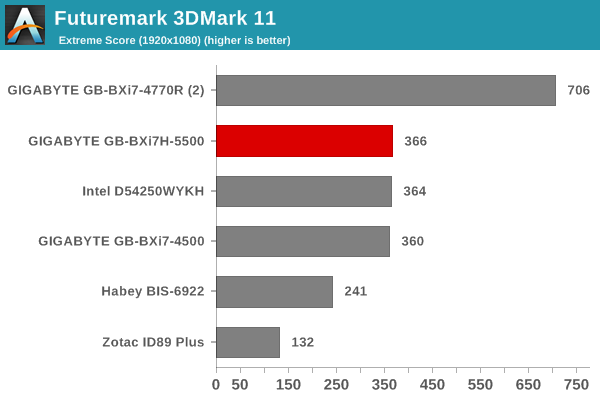
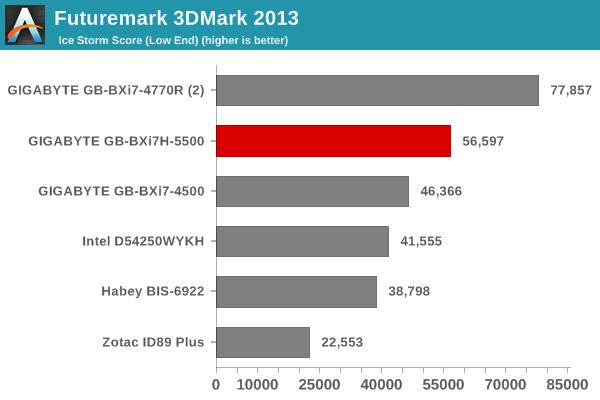
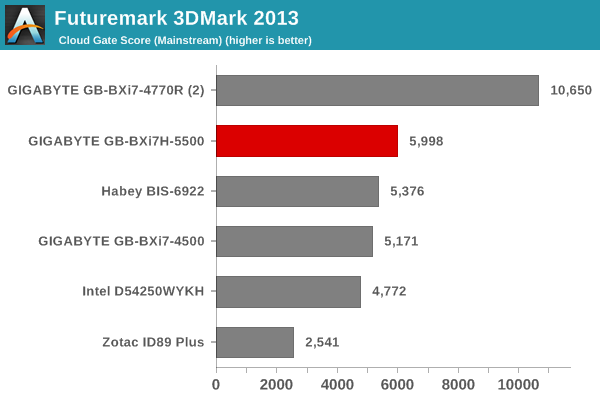
3D Rendering - CINEBENCH R15
We have moved on from R11.5 to R15 for 3D rendering evaluation. CINEBENCH R15 provides three benchmark modes - OpenGL, single threaded and multi-threaded. Evaluation of select PCs in all three modes provided us the following results. There is a slight improvement in the performance of the i7-5500U compared to the i7-4500 - mainly due to the higher clocks that can be sustained by the former while remaining under the required power envelop.
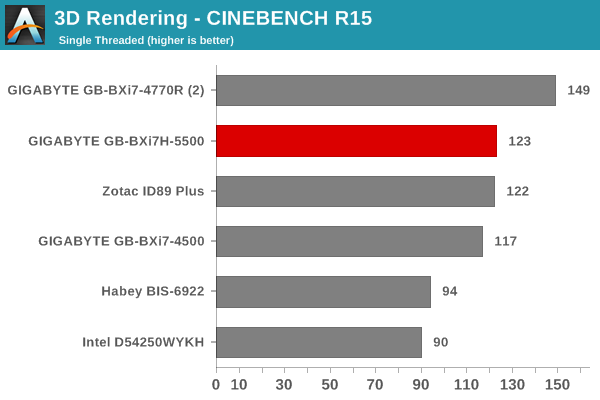
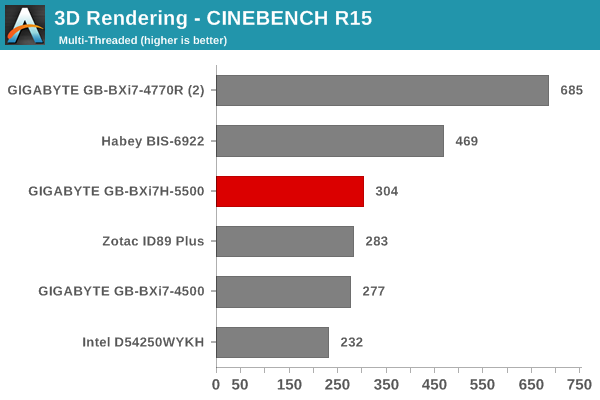
The OpenGL performance shows improvement, thanks to the updated GPU architecture, higher base clocks for the GPU and, possibly, driver updates.











53 Comments
View All Comments
jaydee - Thursday, January 29, 2015 - link
I was hoping for a bit more here from Intel. Looking at the encoding, compressing, encrypting benchmarks, almost nothing was gained performance-wise, or in terms of power consumption.Flunk - Thursday, January 29, 2015 - link
Broadwell is an incremental update so it's not a big surprise.gonchuki - Thursday, January 29, 2015 - link
Doesn't even look incremental, more like a step revision of Haswell (just a node shrink and nothing else). It's the same processor Intel launched in 2013, but on a 14nm node.Refuge - Thursday, January 29, 2015 - link
Tick Tock Tick Tock.Although I've noticed their "Tick Tock" Has been slightly off cadence since their "Mobile First" strategy.
quophog - Friday, January 30, 2015 - link
No surprise really. No competition at all at the performance end. All their effort is going in to the ultra low power & cost end where ARM based architectures currently dominate. Very sad for everyone (except intel share holders) that AMD couldn't keep up with Intel R&D and fab spending.It's a long way off anyway, but I really hope Intel fab advantage doesn't let them eventually monopolise mobile procs too..
Haravikk - Friday, January 30, 2015 - link
Is that really such a bad thing? Making a smaller, much more power efficient processor without sacrificing any performance is still a pretty big accomplishment. While it might not make existing machines much more exiting, the really interesting part is what new things it makes possible.It's for this reason I hate this new Brix machine; it's the same horrific chassis as before, the with the same anaemic cooling. It should be possible for this to be entirely passively cooled, particularly if they want for a smaller, flatter, aluminium design.
eanazag - Friday, January 30, 2015 - link
Intel has done well, but with a competitive AMD we get better prices and more features. ARM has kept Intel moving, but look at the server market. Prices run from $200+ - north of $2000 for 2P systems. And Intel has the middle filled out too. Intel is charging whatever the hell they want there.eanazag - Friday, January 30, 2015 - link
It does look incremental in some benches. In others it is on par. For this type of system I would be leaning towards the 4770R. I don't care for the gaming performance on the 5500U. It is fine at 1280x1024/1366x768. I'd rather have the option to take a step up. The 4770R can do decent in 1600x900/1600x1000. For $750+ I'd like to be doing better. Broadwell Iris Pro may be what I'm hoping for.Otherwise, I'm a 5500U with a mobile GPU built-in - pricing and features may see which way I lean. I'm not a HTPC user.
nathanddrews - Thursday, January 29, 2015 - link
I don't think we should jump to judgment based upon multiple platforms with vastly different components. The closest competitor in this review is the 4500U, which the 5500U decimates in half the benchmarks, while leading it by at least a small margin in the rest. I'm looking forward to a more controlled, thorough review of Broadwell.I know that the gaming tests are set in stone and you try not to change them, but can we please drop the 1280x1024 test and replace it with 1280x720? It's 30% less taxing for these weak GPUs and is much more likely to be used by gamers - either on HDTVs, notebook displays (768p), and widescreen monitors. Nearly all 360/PS3 games are 720p, so many people are comfortable with that resolution and it scales to 1080p, 1440p, and 4K. It's just more realistic. No one games at 1280x1024 anymore unless they like pillarboxing and letterboxing at the same time. 720p and 1080p are really the only meaningful resolutions for these GPUs. You can save yourself some time, too...
ATC9001 - Thursday, January 29, 2015 - link
+1 for 720p resolution. If possible atleast add this to existing HTPC benchmarking, and of course when the benchmark is revamped for it's next iteraion, drop 1280x1024 completely!